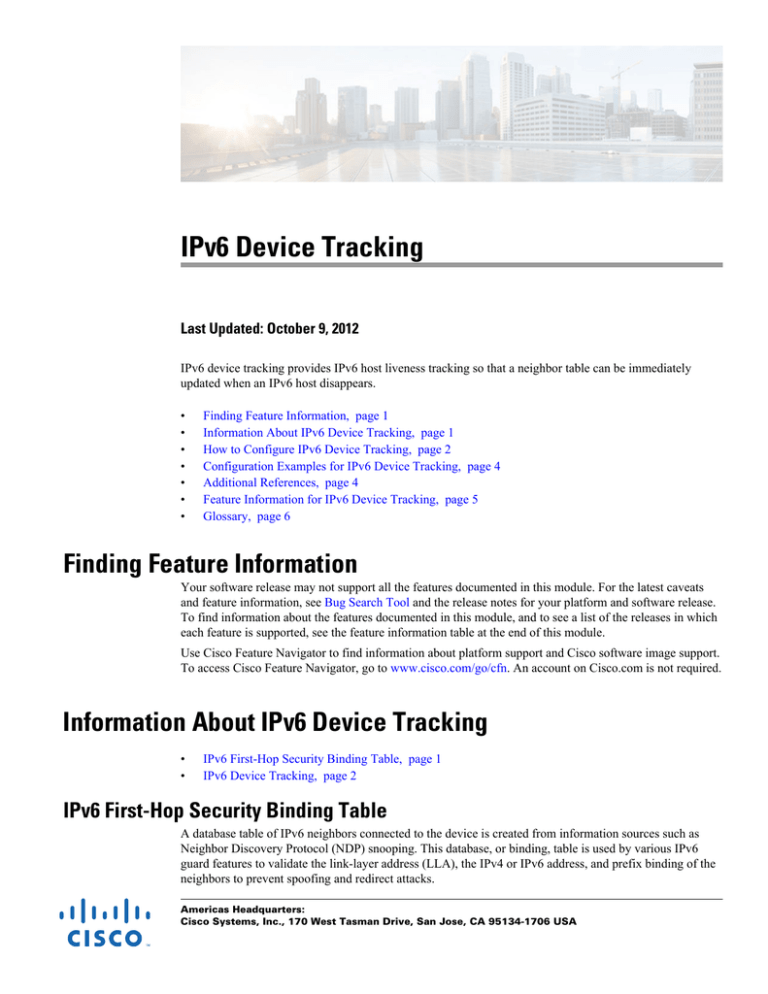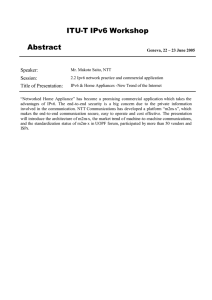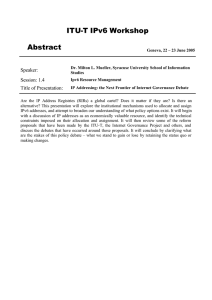
IPv6 Device Tracking
Last Updated: October 9, 2012
IPv6 device tracking provides IPv6 host liveness tracking so that a neighbor table can be immediately
updated when an IPv6 host disappears.
•
•
•
•
•
•
•
Finding Feature Information, page 1
Information About IPv6 Device Tracking, page 1
How to Configure IPv6 Device Tracking, page 2
Configuration Examples for IPv6 Device Tracking, page 4
Additional References, page 4
Feature Information for IPv6 Device Tracking, page 5
Glossary, page 6
Finding Feature Information
Your software release may not support all the features documented in this module. For the latest caveats
and feature information, see Bug Search Tool and the release notes for your platform and software release.
To find information about the features documented in this module, and to see a list of the releases in which
each feature is supported, see the feature information table at the end of this module.
Use Cisco Feature Navigator to find information about platform support and Cisco software image support.
To access Cisco Feature Navigator, go to www.cisco.com/go/cfn. An account on Cisco.com is not required.
Information About IPv6 Device Tracking
•
•
IPv6 First-Hop Security Binding Table, page 1
IPv6 Device Tracking, page 2
IPv6 First-Hop Security Binding Table
A database table of IPv6 neighbors connected to the device is created from information sources such as
Neighbor Discovery Protocol (NDP) snooping. This database, or binding, table is used by various IPv6
guard features to validate the link-layer address (LLA), the IPv4 or IPv6 address, and prefix binding of the
neighbors to prevent spoofing and redirect attacks.
Americas Headquarters:
Cisco Systems, Inc., 170 West Tasman Drive, San Jose, CA 95134-1706 USA
IPv6 Device Tracking
How to Configure IPv6 Device Tracking
IPv6 Device Tracking
The IPv6 Device Tracking feature provides IPv6 host liveness tracking so that a neighbor table can be
immediately updated when an IPv6 host disappears. The feature tracks the liveness of the neighbors
connected through the Layer 2 device on a regular basis in order to revoke network access privileges as
they become inactive.
How to Configure IPv6 Device Tracking
•
•
Configuring IPv6 Binding Table Content, page 2
Configuring IPv6 Device Tracking, page 3
Configuring IPv6 Binding Table Content
SUMMARY STEPS
1. enable
2. configure terminal
3. ipv6 neighbor binding vlan vlan-id {interface type number | ipv6-address | mac-address} [tracking
[disable | enable | retry-interval value] | reachable-lifetime value]
4. ipv6 neighbor binding max-entries entries [vlan-limit number | interface-limit number | mac-limit
number]
5. ipv6 neighbor binding logging
6. exit
7. show ipv6 neighbor binding [vlan vlan-id | interface type number | ipv6 ipv6-address | mac macaddress]
DETAILED STEPS
Command or Action
Step 1 enable
Purpose
Enables privileged EXEC mode.
•
Enter your password if prompted.
Example:
Device> enable
Step 2 configure terminal
Example:
Device# configure terminal
2
Enters global configuration mode.
Configuring IPv6 Device Tracking
How to Configure IPv6 Device Tracking
Command or Action
Purpose
Step 3 ipv6 neighbor binding vlan vlan-id {interface type number | ipv6-address | Adds a static entry to the binding table
database.
mac-address} [tracking [disable | enable | retry-interval value] |
reachable-lifetime value]
Example:
Device(config)# ipv6 neighbor binding vlan 100 interface
Ethernet 0/0 reachable-lifetime 100
Step 4 ipv6 neighbor binding max-entries entries [vlan-limit number | interface- Specifies the maximum number of entries
that are allowed to be inserted in the
limit number | mac-limit number]
binding table cache.
Example:
Device(config)# ipv6 neighbor binding max-entries 100
Step 5 ipv6 neighbor binding logging
Enables the logging of binding table main
events.
Example:
Device(config)# ipv6 neighbor binding logging
Step 6 exit
Exits global configuration mode and enters
privileged EXEC mode.
Example:
Device(config)# exit
Step 7 show ipv6 neighbor binding [vlan vlan-id | interface type number | ipv6
ipv6-address | mac mac-address]
Displays the contents of a binding table.
Example:
Device# show ipv6 neighbor binding
Configuring IPv6 Device Tracking
Perform this task to provide fine tuning for the life cycle of an entry in the binding table for the IPv6
Device Tracking feature. For IPv6 device tracking to work, the binding table needs to be populated.
SUMMARY STEPS
1. enable
2. configure terminal
3. ipv6 neighbor tracking [retry-interval value]
3
Example: Verifying IPv6 Device Tracking
Configuration Examples for IPv6 Device Tracking
DETAILED STEPS
Step 1
Command or Action
Purpose
enable
Enables privileged EXEC mode.
•
Enter your password if prompted.
Example:
Device> enable
Step 2
Enters global configuration mode.
configure terminal
Example:
Device# configure terminal
Step 3
Tracks entries in the binding table.
ipv6 neighbor tracking [retry-interval value]
Example:
Device(config)# ipv6 neighbor tracking
Configuration Examples for IPv6 Device Tracking
•
Example: Verifying IPv6 Device Tracking, page 4
Example: Verifying IPv6 Device Tracking
Device# show ipv6 neighbor tracking
IPv6 address
left
ND FE80::A8BB:CCFF:FE01:F500
L
FE80::21D:71FF:FE99:4900
ND 2001:600::1
ND 2001:300::1
L
2001:400::1
Link-Layer addr Interface vlan prlvl age
state
Time
AABB.CC01.F500
001D.7199.4900
AABB.CC01.F500
AABB.CC01.F500
001D.7199.4900
REACHABLE
DOWN
REACHABLE
REACHABLE
DOWN
8850
N/A
3181
9559
N/A
Et0/0
Vl100
Et0/0
Et0/0
Vl100
100
100
100
100
100
0002
0
0080 7203
0003
0
0007
0
0080 7188
Additional References
Related Documents
4
Related Topic
Document Title
IPv6 addressing and connectivity
IPv6 Configuration Guide
Example: Verifying IPv6 Device Tracking
Feature Information for IPv6 Device Tracking
Related Topic
Document Title
Cisco IOS commands
Cisco IOS Master Commands
List, All Releases
IPv6 commands
Cisco IOS IPv6 Command
Reference
Cisco IOS IPv6 features
Cisco IOS IPv6 Feature Mapping
Standards and RFCs
Standard/RFC
Title
RFCs for IPv6
IPv6 RFCs
MIBs
MIB
MIBs Link
No new or modified MIBs are supported by this
feature, and support for existing MIBs has not been
modified by this feature.
To locate and download MIBs for selected
platforms, Cisco IOS releases, and feature sets, use
Cisco MIB Locator found at the following URL:
http://www.cisco.com/go/mibs
Technical Assistance
Description
Link
The Cisco Support and Documentation website
provides online resources to download
documentation, software, and tools. Use these
resources to install and configure the software and
to troubleshoot and resolve technical issues with
Cisco products and technologies. Access to most
tools on the Cisco Support and Documentation
website requires a Cisco.com user ID and
password.
http://www.cisco.com/cisco/web/support/
index.html
Feature Information for IPv6 Device Tracking
The following table provides release information about the feature or features described in this module.
This table lists only the software release that introduced support for a given feature in a given software
release train. Unless noted otherwise, subsequent releases of that software release train also support that
feature.
Use Cisco Feature Navigator to find information about platform support and Cisco software image support.
To access Cisco Feature Navigator, go to www.cisco.com/go/cfn. An account on Cisco.com is not required.
5
Example: Verifying IPv6 Device Tracking
Glossary
Table 1
Feature Information for IPv6 Device Tracking
Feature Name
Releases
Feature Information
IPv6 Device Tracking
12.2(50)SY
IPv6 device tracking provides
IPv6 host liveness tracking so that
a neighbor table can be
immediately updated when an
IPv6 host disappears.
15.0(1)SY
15.0(2)SE
The following commands were
introduced or modified: ipv6
neighbor binding logging, ipv6
neighbor binding max-entries,
ipv6 neighbor binding vlan,
ipv6 neighbor tracking, show
ipv6 neighbor binding, show
ipv6 neighbor tracking.
Glossary
•
•
•
•
•
•
•
•
•
•
•
•
•
•
•
•
•
•
•
•
6
CA—certification authority.
CGA—cryptographically generated address.
CPA—certificate path answer.
CPR—certificate path response.
CPS—certification path solicitation. The solicitation message used in the addressing process.
CRL—certificate revocation list.
CS—certification server.
CSR—certificate signing request.
DAD—duplicate address detection. A mechanism that ensures two IPv6 nodes on the same link are
not using the same address.
DER—distinguished encoding rules. An encoding scheme for data values.
nonce—An unpredictable random or pseudorandom number generated by a node and used once. In
SeND, nonces are used to ensure that a particular advertisement is linked to the solicitation that
triggered it.
non-SeND node—An IPv6 node that does not implement SeND but uses only the Neighbor Discovery
Protocol without security.
NUD—neighbor unreachability detection. A mechanism used for tracking neighbor reachability.
PACL—port-based access list.
PKI—public key infrastructure.
RA—router advertisement.
RD—Router discovery allows the hosts to discover what devices exist on the link and what subnet
prefixes are available. Router discovery is a part of the Neighbor Discovery Protocol.
Router Authorization Certificate—A public key certificate.
SeND node—An IPv6 node that implements SeND.
trust anchor—An entity that the host trusts to authorize devices to act as devices. Hosts are
configured with a set of trust anchors to protect device discovery.
Example: Verifying IPv6 Device Tracking
Cisco and the Cisco logo are trademarks or registered trademarks of Cisco and/or its affiliates in the U.S.
and other countries. To view a list of Cisco trademarks, go to this URL: www.cisco.com/go/trademarks.
Third-party trademarks mentioned are the property of their respective owners. The use of the word partner
does not imply a partnership relationship between Cisco and any other company. (1110R)
Any Internet Protocol (IP) addresses and phone numbers used in this document are not intended to be
actual addresses and phone numbers. Any examples, command display output, network topology diagrams,
and other figures included in the document are shown for illustrative purposes only. Any use of actual IP
addresses or phone numbers in illustrative content is unintentional and coincidental.
© 2012 Cisco Systems, Inc. All rights reserved.
7



